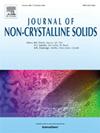石墨烯修饰的锗基玻璃作为锂离子电池的高容量负极材料
IF 3.2
3区 材料科学
Q1 MATERIALS SCIENCE, CERAMICS
引用次数: 0
摘要
锂离子电池(LIB)的性能在很大程度上取决于其负极材料。目前,锗基负极材料因其理论容量高而备受关注,但有关锗基玻璃负极材料的研究较少。在这项工作中,利用球磨技术制造了石墨烯混合锗基玻璃复合材料。石墨烯的加入大大降低了锗基玻璃阳极在循环过程中的电荷转移电阻。同时,该复合阳极在第一个放电循环中表现出 1101.5 mAh g-1 的高比容量,在电流密度为 500 mA g-1 的条件下,放电/充电比容量在 450 个循环后仍高达 1108.2/1098.6 mAh g-1。此外,在 2 A g-1 的高电流下,复合阳极仍能保持 437.2 mAh g-1 的高放电比容量,且表面无明显膨胀,显示出极佳的稳定性。希望目前的研究工作能为今后优化锗基玻璃阳极材料的研究提供新的方向。本文章由计算机程序翻译,如有差异,请以英文原文为准。
Germanium based glass modified by graphene as anode material with high capacity for lithium-ion batteries
The performance of a lithium-ion battery (LIB) is largely contingent upon its anode material. At present, germanium-based anode materials are of interest due to their high theoretical capacity, but there are fewer studies on germanium-based glass anode materials. In this work, graphene mixed germanium-based glass composite material was fabricated utilizing the ball-milling technique. The addition of graphene greatly reduces the charge transfer resistance of the germanium-based glass anode during cycling. Meanwhile, the composite anode exhibited a high specific capacity of 1101.5 mAh g-1 during the first discharge cycle, and the discharge/charge specific capacity was still as high as 1108.2/1098.6 mAh g-1 after 450 cycles at a current density of 500 mA g-1. Moreover, at a high current of 2 A g-1, the composite anode still maintains a high discharge specific capacity of 437.2 mAh g-1, and there is no obvious swelling on the surface, showing excellent stability. It is hoped that the current research endeavor may offer a fresh direction for future studies aimed at optimizing germanium-based glass anode materials.
求助全文
通过发布文献求助,成功后即可免费获取论文全文。
去求助
来源期刊

Journal of Non-crystalline Solids
工程技术-材料科学:硅酸盐
CiteScore
6.50
自引率
11.40%
发文量
576
审稿时长
35 days
期刊介绍:
The Journal of Non-Crystalline Solids publishes review articles, research papers, and Letters to the Editor on amorphous and glassy materials, including inorganic, organic, polymeric, hybrid and metallic systems. Papers on partially glassy materials, such as glass-ceramics and glass-matrix composites, and papers involving the liquid state are also included in so far as the properties of the liquid are relevant for the formation of the solid.
In all cases the papers must demonstrate both novelty and importance to the field, by way of significant advances in understanding or application of non-crystalline solids; in the case of Letters, a compelling case must also be made for expedited handling.
 求助内容:
求助内容: 应助结果提醒方式:
应助结果提醒方式:


